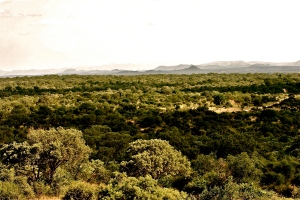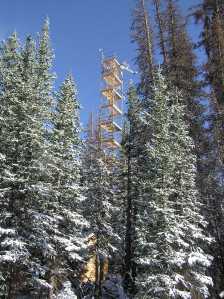
Event: February, 2013- Front Range Student Ecology Symposium Highlights
The Front Range Student Ecology Symposium was a great success this year! Here are summaries of the award winner’s presentations and some other highlights.
1st Place
The Theoretical and Integrative Effects of Tree Harvest and Fire on Grassland-Savanna-Forest Transitions — Andrew Tredennick (Natural Resource Ecology Lab and Graduate Degree Program in Ecology)

Broadly speaking, if we know how much rainfall a given area receives over the course of an average year, we can predict what type of biome (for example, forest or desert) is most likely to be present. But throughout the tropics, even in places where there is enough rainfall to support a forest, savannas (mixed tree-grass systems without a closed-canopy) persist. Much work in the past decade has focused on how fire can exclude forest trees that do not resprout after burning and limit the transition of small savanna saplings to large, fire-immune, savanna adult trees. This has led to recent interpretations of savanna and forest being alternate stable states — that is, under the same climate, both the forest state and the savanna state are stable, dependent on the presence of fire.
In addition to fire, Andrew proposed that tree harvest for fuelwood (the main source of energy in Sub-Saharan Africa) may also play a role in limiting adult tree cover and making a transition from forest to savanna more probable. He took a simple model proposed by Carla Staver and Simon Levin and added tree harvest assuming that savanna trees resprout following harvest, whereas forest trees simply die. Under these assumptions, tree harvest indirectly increases the frequency of fire, which in turn can cause a transition from a forest to a savanna. Though this work is theoretical, it has very real implications. Tree harvesting for fuelwood is predicted to increase in the future, and Andrew’s work indicates that without active fire suppression following tree harvest we should expect to see shifts in the distribution of savanna relative to forest.
2nd Place
Are Rocky Mountain Tree Species Responding to Climate Change? — Katie Renwick (Natural Resource Ecology Lab, Dept. of Ecosystem Science and Sustainability, and Graduate Degree Program in Ecology)
The impacts of climate change on tree species can be direct and indirect. Since many tree species are used to a certain temperature or rainfall pattern, climate change can directly influence distributions of certain species based on those factors alone. However, change in climate can also create new opportunities for things that impact trees like insects (for example mountain pine beetle in the mountain west) or fire. Katie undertook an observational study at species’ ecotones (where species overlap, since at any given elevation/climate a certain species is dominant) to see whether Rocky Mountain tree species were responding to climate change by changing their ranges (by moving up in elevation, for example). Further, she proposed that, in combination, the direct and indirect effects of climate change will cause more rapid range shifts than either in isolation. For example, disturbance-related deaths by insects or fire may free up resources at higher elevations that can speed up range shifts.

Katie found that most species have in fact moved up in elevation, suggesting that Rocky Mountain trees are responding to climate change. Likewise, she found that when disturbance had occurred primarily through tree deaths related to mountain pine beetle, the density of young seedlings of the species “moving up” in elevation was greater. This showed that disturbances are a key ingredient for rapid range shifts in response to climate change. In fact, Katie showed that the impact of pine beetle is greater than the direct effects of climate change in isolation.
3rd Place
Predicting the Effects of Climate Change: The Role of Phenotypic Plasticity and Predatory-Prey Interaction in Pseudacris maculata Metamorphosis — Staci Amburgey (Department of Biology and Graduate Degree Program in Ecology)
One of the most certain predictions for future climate change is that climate will become more variable. This means that species that depend upon ephemeral (something that lasts only for a short time) water resources will be more vulnerable to increasingly frequent drought. This is especially so for frogs (such as Pseudacris maculata) that depend on short-term ponds to undertake metamorphosis — with more frequent droughts, mortality will increase. There are three ways to buffer the mortality effects of climate change for frogs: (1) adapt, (2) have “plastic” traits (that is, highly variable traits among individuals within a species that allow them to take advantage of a broad range of conditions), and (3) disperse (that is, move away from bad conditions). Of these mechanisms, only plasticity allows an organism to both stay in its current location and respond rapidly to changes. So, Staci asked whether plasticity in the rate of metamorphosis (that is, an individual’s ability to speed up metamorphosis) is enough to buffer the impacts of climate change.
Staci collected tadpoles from the field and then brought them back to her laboratory at CSU to set up an experiment where she simulated drought conditions under different rates of predation (basically, in some jars there were more things that ate the tadpoles!). Staci found that metamorphosis was more rapid under climate change scenarios (a reduction in the wet period), but only when rates of predation were high too. She suggests that plasticity is energetically expensive (like running up stadium stairs over and over), and requires the interaction of predation and climate change for these frog species to invest their energy toward a faster metamorphosis. Basically, this means that being able to speed up or down metamorphosis (being “plastic”) helps, but it doesn’t quite buffer against climate change unless predators are also present to incentivize an investment in rapid metamorphosis.
Highlights
Forest Respiration from Eddy Covariance and Chamber Measurements Under High Turbulence and 85% Overstory Mortality — Heather Speckman (Natural Resource Ecology Lab and Graduate Degree Program in Ecology)

Plants take up CO2 from the atmosphere through photosynthesis and release CO2 through respiration. Since plants grow when they take up more CO2 through photosynthesis than they lose through respiration, measuring the flux of CO2 in and out of forests is key to understanding their health. The fluxes are measured in two ways: (1) scaling chamber measurements, where a small part of a tree is enclosed to measure the fluxes, and the values are scaled up to the stand; (2) eddy covariance techniques, where CO2 concentration in the atmosphere, wind speed and direction are tracked along a vertical cross section of the forest. Chamber measurements have to be made numerous times to capture the entire forest accurately, while eddy covariance technique needs the air within the forest to mix well.

The two methods should produce the same flux values, but often chamber measurements of plant respiration result in 30% higher values than from eddy covariance. Heather and her colleagues tested the accuracy of both methods in a pine forest in Wyoming (very windy) where pine beetle outbreak has killed 85% of the forest trees. She found that the chamber measurements detected a 35% decrease in plant respiration before and after the beetle outbreak, but eddy covariance detected no change. She also found that chamber measurements resulted in values three times higher than from eddy covariance. Her results suggest that both methods have systematic sources of error.
Modeling for Optimal Bioenergy Landscape Design — John Field (Department of Mechanical Engineering and Natural Resource Ecology Lab)
The Renewable Fuel Standard established under the Energy Policy Act of 2005 (and expanded under the Energy Independence and Security Act of 2007) requires, by 2022, an increase in production to 36 billion gallons in renewable fuels that emit less greenhouse gasses than the fossil fuels they replace over their life cycle. One of the renewable fuels is bioethanol, commonly made by fermenting crops like corn, but expected to be made from cellulosic feedstocks like switchgrass in the future. Since crops take up CO2 from the atmosphere to grow, bioethanol production can emit fewer greenhouse gasses than fossil fuels over the crop’s life cycle. However, the actual balance of biogenic greenhouse gasses such as CO2 and N2O can vary widely depending on crop management practices, and where on the landscape crops are grown. Growing crops in more favorable soil patches increases efficiency of biomass production, but also increases emissions from equipment and biomass transport if the soil patches are too spread apart.

John and his colleagues modeled the most efficient way to produce switchgrass for bioethanol at the landscape level in a case study for western Kansas. He found that soils varied widely in productivity and greenhouse gas balance across this heterogeneous landscape. He then developed an algorithm that balances productivity, emissions, and cost, to find where best to locate crop fields and facilities. His research is one of the first efforts to integrate these often competing factors in cellulosic bioethanol system design. You can find out more about John’s research and the BioEnergy IGERT here.